Meet Sandy: The Service Dog in Training on Campus
Sandy tracking where she is supposed to be keeping attention.
Walking the halls of EvCC you tend to see a lot of the same things: student’s, stairs, study areas. But something you might not expect to see is Sandy.
Sandy is an 8 month-old golden Labrador retriever who is on her way to becoming a service dog for EvCC student, Angeles Roman.
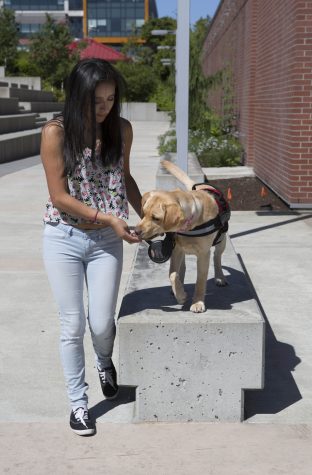
Roman rewards Sandy with treats while she is doing her job to let her know that what she is doing is appropriate.
Her Human
19-year-old Angeles Roman, who prefers to be called Lizzy, was a young girl when she came to the United States from Mexico. Roman’s biological mother asked her biological father to send her from Mexico, in hopes for a better education.
At 14 years old, Roman found herself without home or family and in the foster system. She went to more than five different foster homes. Roman says that they were all different, and that in some “I wasn’t fed.”
She finally ended up with her current foster mom on April 25, 2014, and she quickly became more than a foster mom. Roman started calling her mom and has stayed close to her.
Roman’s mom was determined to help Roman when she came to her. Roman said, “She wanted me to be healthy on the inside, too.” So, Roman began counseling in 2014.
The counselor recommended a service dog for Lizzy for post-traumatic stress disorder and anxiety.
Sandy’s Beginning
Sandy was not an easy dog to find, and truth be told, she wasn’t Roman’s ideal dog.
When Roman got the okay to look for a service dog, she enlisted her mom who, in typical mom fashion, sent out a brigade of helpers. On her own, Roman prowled website after website searching for a black, female Labrador retriever.
The breed was a must for Roman because she knew Labrador retrievers are known for being easily trained. She found black Labrador retrievers more visually appealing, but she wanted a female more because many others had informed her that females were less aggressive.
It took Roman three months to find Sandy. A family friend, who is also a veterinarian, helped make the connection with Roman to a breeder. They only had male, black Labrador retrievers and female, golden Labrador retrievers. Roman made the decision to get Sandy, a female, golden Labrador retriever. Roman says, “I found her and I was like I have to take this chance. I can’t look any longer I need her.”
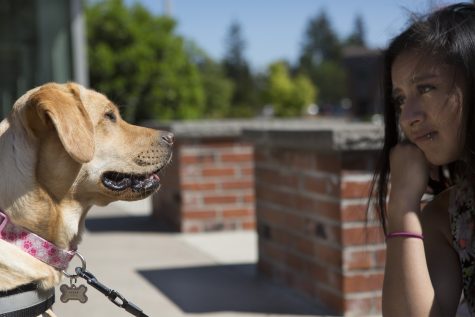
A service dog in training should always have their focus on their handler when working. Here you see Roman teaching Sandy to keep attention on her.
Dogs with Jobs
Sandy accompanies Roman to EvCC twice a week on average because she is a service dog in training. Sandy is being trained to calm down Lizzy when people approach her.
One of Sandy’s commands is when Roman pats her thigh, Sandy is supposed to put her head on Roman’s thigh to calm her as someone approaches her. The purpose of this training links back to Roman’s anxiety when people approach. This way, Roman can calm down while petting Sandy.
According to Karen Ehnat, Director of Center for Disability Services, service dogs in training, comfort dogs and therapy dogs must be approved to be on campus through the disability center. Service animals are the only working animals covered under federal law that do not need approval.

This is Sandy’s vest so that everyone knows she is in training to be a service dog. One of the purposes of this vest is to let others know not to approach Sandy as she is working.
Comfort, therapy, emotional support and companion animals are not considered service dogs because they do not have a specific task they perform for a disabled handler. Instead, these dogs may calm people with their presence or be used to help others rather than their handler.
EvCC’s Center for Disability Services chooses to handle these types of dogs on a case by case basis and acceptations have been made for students as accommodations. The disability center will also be able to help with housing accommodations and more for these types of animals.
However, the rules with service dogs are different than with service dogs in training because service dogs in training or not covered by federal law. The Americans with Disabilities Act states that there are only two questions that staff can ask a person with a service animal. “(1) is the dog a service animal required because of a disability? And (2) what work or task has the dog been trained to perform?”
Sandy is considered a service dog in training because she is being trained to perform a task for someone with a disability.

A command Roman is teaching is Sandy is to kiss.
What to Do
When you see any type of service animal, as hard as it may be, it is important to ignore them. Roman’s teacher, Sue Grigsby is an avid dog lover and has a pup of her own. So Grigsby can recognize the difficulty in not addressing a service dog. However, Grigsby said that, “you wouldn’t address someone’s cane or wheelchair,” and that the fact that the dog is working has to take precedence.
One of the things Roman struggles with is people approaching her. It was one of the reasons she got Sandy in the first place. Now, people see she has a service dog in training and they run up to her. Roman tells them she has a service dog in training but some people still just don’t understand that Sandy is a working dog.
Some disabilities are not easily seen by just looking at them. You don’t know what someone is struggling with, so it is very important you don’t interact with their service animals.
Roman and Sandy will hopefully be returning to EvCC in the fall. Roman doesn’t know if she will be fully trained by then but is happy that her training, “Right now is going really well. Sometimes she doesn’t listen. Sometimes she does… but it’s getting a lot better.”
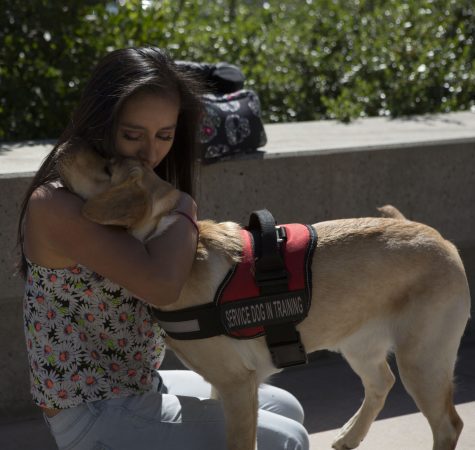
One of the commands Sandy is being taught is to hug Lizzy to calm her down.

What are your future plans in journalism?
It looks like I am headed into the realm of communications but I will always look back at journalism as a...

What do you like to write about?
Travel and the humor that ensues on long road trips.
What Disney (or fictional) character are you?
I'd say...

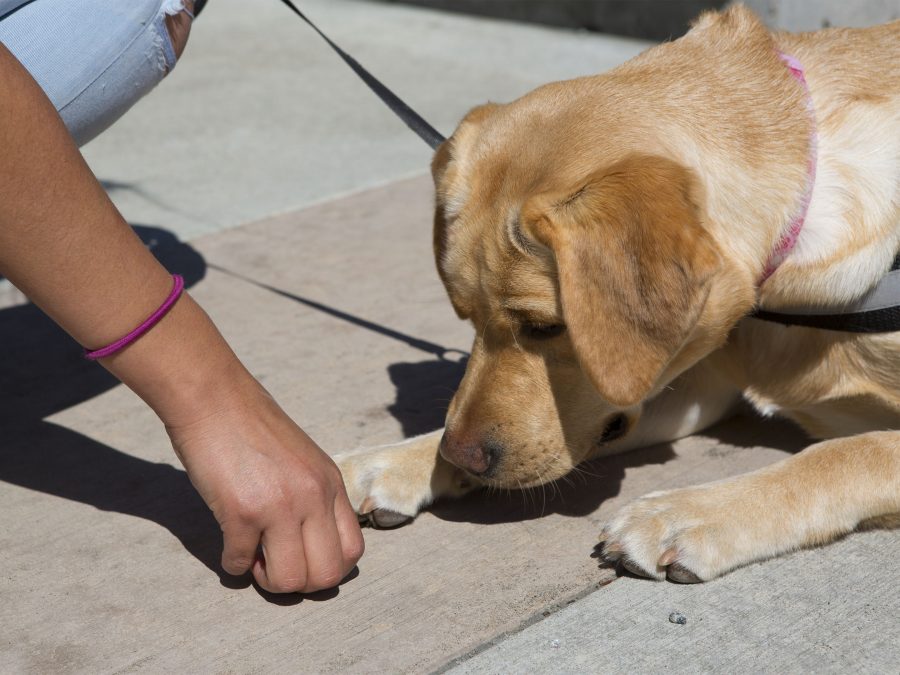

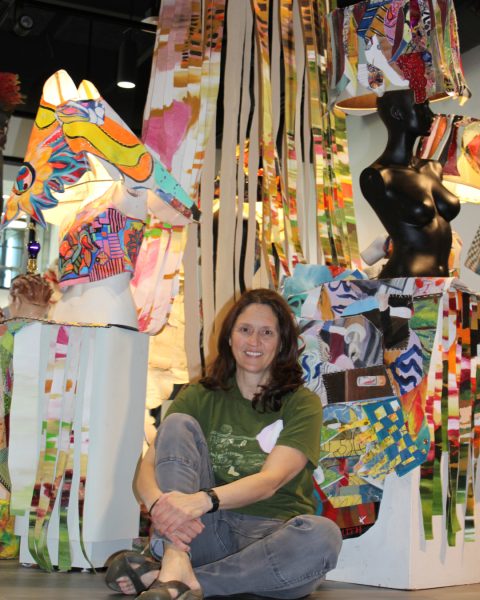



Debbie Kenoyer • May 24, 2016 at 9:56 pm
So many people don’t realize that a dog in training, at least a pup, has a short interest span and it takes a lot to keep a dog on point. Very informative article I wish more awareness would be put towards people with disabilities and service animals.
Dolores Berry • May 24, 2016 at 5:36 pm
Very nicely done, Cassie
Norene Wirtz • May 24, 2016 at 3:22 pm
An excellent article and very informative. I enjoyed learning about service dogs.